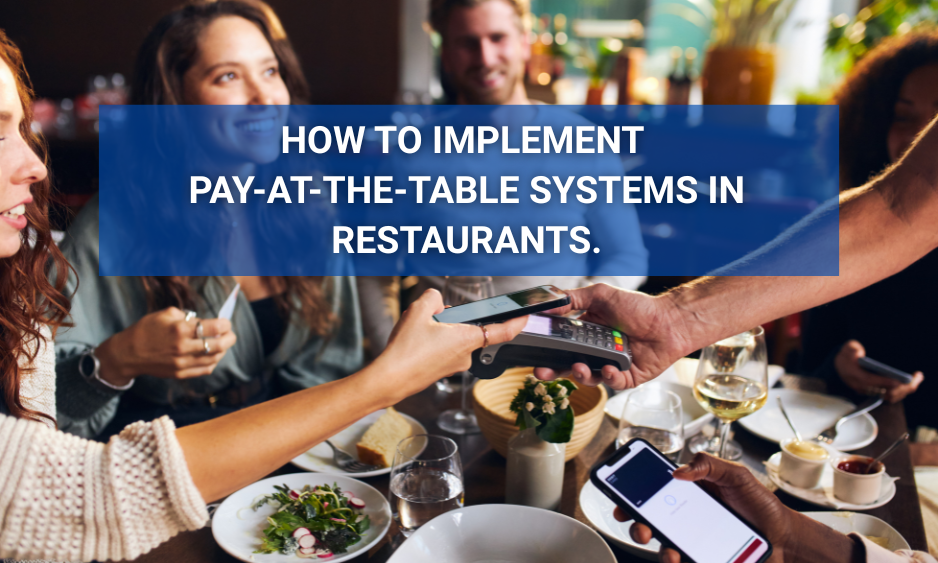Introduction to Pay-at-the-Table Technology
If you’re still taking payments the old-school way—walking back and forth with a receipt and a card machine—it might be time for a change. Pay-at-the-table systems are revolutionizing the dining experience. They let customers settle the bill right from their seats. No waiting, no awkward eye contact while waving for the check.
In this article, we’ll walk you through how to implement pay-at-the-table tech the smart way, step by step.
Why Restaurants Are Making the Switch
Restaurants, both big-name chains and cozy local joints, are jumping on this trend. Why? Because it just makes life easier—for everyone.
Enhanced Customer Experience
Imagine wrapping up a meal, and within seconds, you’re scanning a QR code, tipping your server, and you’re out the door. That’s what today’s diners expect: speed and convenience.
Faster Table Turnover
When guests aren’t stuck waiting for the check, tables flip faster. That means more customers, more revenue, and less downtime.
Improved Payment Security
With EMV chip readers and encrypted mobile payments, customer data stays protected. No one wants to hand over their card for someone to disappear with it for five minutes.
Types of Pay-at-the-Table Solutions
Not all systems are created equal. There are a few main options to consider based on your restaurant’s vibe and needs.
Wireless Terminals
These are handheld devices your servers bring directly to the table. They swipe, tap, or insert cards on the spot—easy and familiar.
Mobile Apps and QR Code Menus
Want a low-touch or contactless option? QR codes link to your digital menu and allow customers to pay through their smartphones.
Smart POS Tablets
Some restaurants go fully digital with tablets at the table. These can show the menu, take orders, and handle payments, all in one sleek device.
How to Choose the Right System
Alright, now the big question: which one should you go with?
Know Your Budget
First, be real about what you can afford. Some systems are subscription-based, while others require upfront investment in hardware.
Evaluate Your Restaurant’s Needs
Are you a casual café or a high-end bistro? A busy diner or a trendy food truck? Your service style should shape your tech choices.
Look for Integration with Existing POS
You don’t want to be juggling multiple platforms. Make sure the pay-at-the-table system works with your current POS setup, not against it.
Step-by-Step Implementation Process
Here’s where the rubber meets the road. Follow these steps to roll out your new system without chaos.
Step 1: Assess Your Current Setup
Start by auditing your existing hardware, Wi-Fi strength, and POS system. You need a solid foundation before layering on new tech.
Step 2: Select the Best System for You
Compare features, read reviews, and talk to reps. Ask for demos, and don’t be afraid to test more than one option.
Step 3: Train Your Staff
They’re the ones who will make or break the transition. Train servers, hosts, and managers thoroughly so they can guide guests confidently.
Step 4: Update Your Menu & Software
If you’re going digital, make sure your menu is optimized for mobile browsing. Nobody wants to pinch and zoom on a poorly designed PDF.
Step 5: Launch and Promote It
When you’re ready, go live! Announce the new system with table signage, a post on social media, and a quick staff briefing on how to explain it to guests.
Staff Training and Onboarding
Let’s be honest—some staff members might resist change. That’s normal.
Make It Hands-On
Let them use the devices in a real setting. Muscle memory helps way more than a boring slideshow.
Handle Objections and Concerns
Listen to feedback. If a server says the tablet is glitchy or slow, take it seriously. Their insights are gold.
How to Inform and Educate Customers
You don’t want your guests scratching their heads when the check never comes.
Table Tents and Signage
Place clear signs on the table explaining how to pay. A simple “Scan to Pay” with a QR code can work wonders.
Server Scripting Tips
Train your staff to say something like, “Whenever you’re ready, you can scan this code to pay at the table.”
Use Social Media and Email
Let your followers and email list know about your new tech. Frame it as a cool, time-saving feature.
Common Pitfalls to Avoid
Even the best systems can flop if you’re not careful. Watch out for these landmines.
Ignoring Staff Feedback
They’re on the front lines. If they say something’s not working, believe them.
Failing to Test the System Thoroughly
Do a full test run before launch. That means testing payments, tips, receipts, and refunds.
Poor Wi-Fi Infrastructure
Nothing kills the vibe like a laggy payment screen. Invest in solid Wi-Fi or a backup hotspot.
Measuring Success Post-Launch
Congrats, your system is live! Now what?
Analyze Payment Time Reduction
Compare payment times before and after implementation. If guests are paying faster, that’s a win.
Check Customer Satisfaction Scores
Ask guests how they liked the new system. A simple feedback form or a post-meal survey can reveal a lot.
Monitor Error Rates and Refunds
If you’re seeing more mistakes, glitches, or chargebacks, it’s time to troubleshoot.
Final Thoughts
Implementing a pay-at-the-table system might feel like a big leap, but it’s one of the smartest moves a modern restaurant can make. You’ll boost efficiency, keep customers happy, and stay ahead of the competition. Start small, train well, and always listen to your team. Before you know it, you’ll wonder how you ever lived without it.
FAQs
1. What is a pay-at-the-table system?
It’s a tech setup that lets customers pay their bill right at the table, using handheld terminals, tablets, or their own smartphones.
2. How much does it cost to implement pay-at-the-table technology?
Costs vary depending on the system. Expect to spend anywhere from a few hundred to several thousand dollars depending on hardware, software, and subscription fees.
3. Can pay-at-the-table systems integrate with my existing POS?
Many systems are designed to work seamlessly with popular POS platforms. Always confirm compatibility before buying.
4. Do customers like paying at the table?
Most do! It’s faster, more secure, and offers greater control over the tipping and receipt process.
5. What happens if the internet goes down?
Some devices offer offline mode or cellular fallback. Still, having strong internet or a backup solution is critical.

